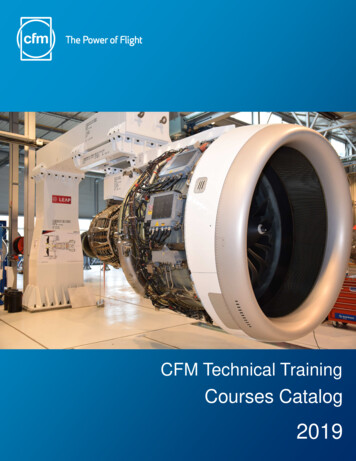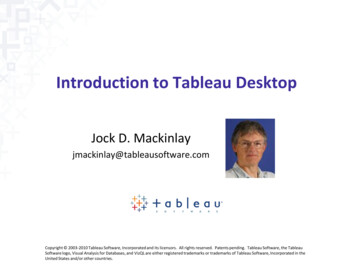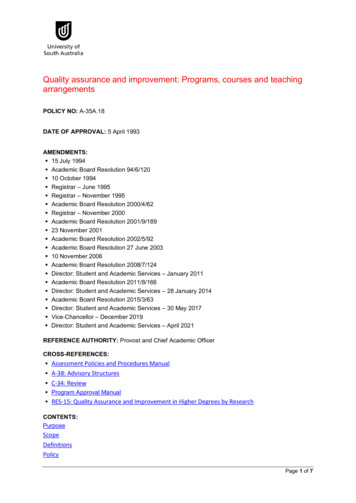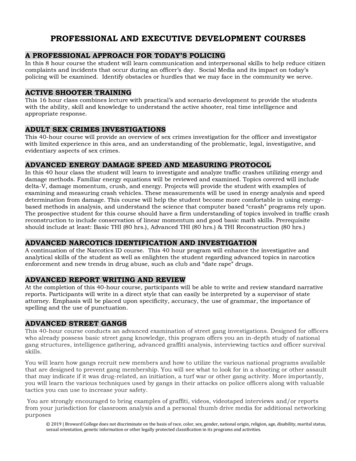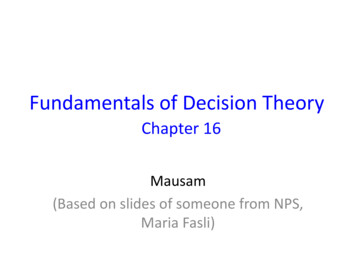
Transcription
Fundamentals of Decision TheoryChapter 16Mausam(Based on slides of someone from NPS,Maria Fasli)
Decision Theory “an analytic and systematic approach to the study ofdecision making” Good decisions:based on reasoning Bad decisions:not based on reasoning consider all available data andpossible alternatives do not consider all available data andpossible alternatives employ a quantitative approach do not employ a quantitative approach– A good decision may occasionally result in anunexpected outcome; it is still a good decision ifmade properly– A bad decision may occasionally result in a goodoutcome if you are lucky; it is still a bad decision
Steps in Decision Theory1. List the possible alternatives (actions/decisions)2. Identify the possible outcomes3. List the payoff or profit or reward4. Select one of the decision theory models5. Apply the model and make your decision
ExampleThe Thompson Lumber Company Problem.– The Thompson Lumber Co. must decide whether or notto expand its product line by manufacturing andmarketing a new product, backyard storage sheds Step 1: List the possible alternativesalternative: “a course of action or strategythat may be chosen by the decision maker”– (1) Construct a large plant to manufacture the sheds– (2) Construct a small plant– (3) Do nothing
The Thompson Lumber Company Step 2: Identify the states of nature– (1) The market for storage sheds could be favorable high demand– (2) The market for storage sheds could be unfavorable low demandstate of nature: “an outcome over which thedecision maker has little or no control”e.g., lottery, coin-toss, whether it will rain today
The Thompson Lumber Company Step 3: List the possible rewards– A reward for all possible combinations of alternativesand states of nature– Conditional values: “reward depends upon thealternative and the state of nature” with a favorable market:– a large plant produces a net profit of 200,000– a small plant produces a net profit of 100,000– no plant produces a net profit of 0 with an unfavorable market:– a large plant produces a net loss of 180,000– a small plant produces a net loss of 20,000– no plant produces a net profit of 0
Reward tables A means of organizing a decision situation, including therewards from different situations given the possiblestates of natureActions12States of NatureabReward 1aReward 1bReward 2aReward 2b– Each decision, 1 or 2, results in an outcome, or reward, forthe particular state of nature that occurs in the future– May be possible to assign probabilities to the states ofnature to aid in selecting the best outcome
The Thompson Lumber CompanyStates of NatureActions
The Thompson Lumber CompanyActionsLarge plantSmall plantNo plantStates of NatureFavorable Market Unfavorable Market 200,000- 180,000 100,000- 20,000 0 0
The Thompson Lumber Company Steps 4/5: Select an appropriate model andapply it– Model selection depends on the operatingenvironment and degree of uncertainty
Decision Making Environments Decision making under certainty Decision making under uncertainty– Non-deterministic uncertainty– Probabilistic uncertainty (risk)
Decision Making Under Certainty Decision makers know with certainty theconsequences of every decision alternative– Always choose the alternative that results in thebest possible outcome
Non-deterministic UncertaintyActionsLarge plantSmall plantNo plantStates of NatureFavorable Market Unfavorable Market 200,000- 180,000 100,000- 20,000 0 0 What should we do?
Maximax Criterion“Go for the Gold” Select the decision that results in themaximum of the maximum rewards A very optimistic decision criterion– Decision maker assumes that the most favorablestate of nature for each action will occur Most risk prone agent
MaximaxDecisionLarge plantSmall plantNo plantStates of NatureFavorableUnfavorable 200,000- 180,000 100,000- 20,000 0 0Maximumin Row 200,000 100,000 0 Thompson Lumber Co. assumes that the most favorablestate of nature occurs for each decision alternative Select the maximum reward for each decision– All three maximums occur if a favorable economyprevails (a tie in case of no plant) Select the maximum of the maximums– Maximum is 200,000; corresponding decision is tobuild the large plant– Potential loss of 180,000 is completely ignored
Maximin Criterion“Best of the Worst” Select the decision that results in themaximum of the minimum rewards A very pessimistic decision criterion– Decision maker assumes that the minimumreward occurs for each decision alternative– Select the maximum of these minimum rewards Most risk averse agent
MaximinDecisionLarge plantSmall plantNo plantStates of NatureFavorableUnfavorable 200,000- 180,000 100,000- 20,000 0 0Minimumin Row- 180,000- 20,000 0 Thompson Lumber Co. assumes that the least favorablestate of nature occurs for each decision alternative Select the minimum reward for each decision– All three minimums occur if an unfavorable economyprevails (a tie in case of no plant) Select the maximum of the minimums– Maximum is 0; corresponding decision is to do nothing– A conservative decision; largest possible gain, 0, ismuch less than maximax
Equal Likelihood Criterion Assumes that all states of nature are equally likely tooccur– Maximax criterion assumed the most favorable state ofnature occurs for each decision– Maximin criterion assumed the least favorable state ofnature occurs for each decision Calculate the average reward for each alternative andselect the alternative with the maximum number– Average reward: the sum of all rewards divided by thenumber of states of nature Select the decision that gives the highest average reward
Equal LikelihoodDecisionLarge plantSmall plantNo plantStates of NatureFavorableUnfavorable 200,000- 180,000 100,000- 20,000 0 0RowAverage 10,000 40,000 0Row Averages 200,000 180,000 10,000Large Plant 2 100,000 20,000 40,000Small Plant2 0 0 0Do Nothing2 Select the decision with the highest weighted value– Maximum is 40,000; corresponding decision is tobuild the small plant
Criterion of Realism Also known as the weighted average or Hurwicz criterion– A compromise between an optimistic and pessimistic decision A coefficient of realism, , is selected by the decisionmaker to indicate optimism or pessimism about the future0 1When is close to 1, the decision maker is optimistic.When is close to 0, the decision maker is pessimistic. Criterion of realism (row maximum) (1- )(rowminimum)– A weighted average where maximum and minimum rewardsare weighted by and (1 - ) respectively
Criterion of Realism Assume a coefficient of realism equal to 0.8DecisionLarge plantSmall plantNo plantStates of NatureFavorableUnfavorable 200,000- 180,000 100,000- 20,000 0 0Criterion ofRealism 124,000 76,000 0Weighted AveragesLarge Plant (0.8)( 200,000) (0.2)(- 180,000) 124,000Small Plant (0.8)( 100,000) (0.2)(- 20,000) 76,000Do Nothing (0.8)( 0) (0.2)( 0) 0Select the decision with the highest weighted valueMaximum is 124,000; corresponding decisionis to build the large plant
Minimax Regret Regret/Opportunity Loss: “the differencebetween the optimal reward and the actualreward received” Choose the alternative that minimizes themaximum regret associated with eachalternative– Start by determining the maximum regret for eachalternative– Pick the alternative with the minimum number
Regret Table If I knew the future, how much I’d regret mydecision Regret for any state of nature is calculated bysubtracting each outcome in the column fromthe best outcome in the same column
Minimax RegretStates of ffRegretLarge plant 200,000- 180,000 180,000 0Small plant 100,000 100,000 - 20,000 20,000 200,000 0No plant 0 0Best payoff 200,000 0 Select the alternative with the lowestmaximum regretMinimum is 100,000; correspondingdecision is to build a small plantRowMaximum 180,000 100,000 200,000
Summary of ResultsCriterionMaximaxMaximinEqual likelihoodRealismMinimax regretDecisionBuild a large plantDo nothingBuild a small plantBuild a large plantBuild a small plant
Decision Making Environments Decision making under certainty Decision making under uncertainty– Non-deterministic uncertainty– Probabilistic uncertainty (risk)
Probabilistic Uncertainty Decision makers know the probability ofoccurrence for each possible outcome– Attempt to maximize the expected reward Criteria for decision models in this environment:– Maximization of expected reward– Minimization of expected regret Minimize expected regret maximizing expected reward!
Expected Reward (Q) called Expected Monetary Value (EMV) in DT literature “the probability weighted sum of possible rewards foreach alternative”– Requires a reward table with conditional rewards andprobability assessments for all states of natureQ(action a) (reward of 1st state of nature)X (probability of 1st state of nature) (reward of 2nd state of nature)X (probability of 2nd state of nature) . . . (reward of last state of nature)X (probability of last state of nature)
The Thompson Lumber Company Suppose that the probability of a favorable market is exactly the same asthe probability of an unfavorable market. Which alternative would givethe greatest Q?DecisionLarge plantSmall plantNo plantStates of NatureFavorable Mkt Unfavorable Mktp 0.5p 0.5EMV 200,000- 180,000 10,000 40,000 100,000- 20,000 0 0 0Q(large plant) (0.5)( 200,000) (0.5)(- 180,000) 10,000Q(small plant) (0.5)( 100,000) (0.5)(- -20,000) 40,000Q(no plant) (0.5)( 0) (0.5)( 0) 0Build the small plant
Expected Value of Perfect Information(EVPI) It may be possible to purchase additionalinformation about future events and thus make abetter decision– Thompson Lumber Co. could hire an economist toanalyze the economy in order to more accuratelydetermine which economic condition will occur in thefuture How valuable would this information be?
EVPI Computation Look first at the decisions under each state ofnature– If information was available that perfectly predictedwhich state of nature was going to occur, the bestdecision for that state of nature could be made expected value with perfect information (EV w/ PI): “theexpected or average return if we have perfect informationbefore a decision has to be made”
EVPI Computation Perfect information changes environment fromdecision making under risk to decision makingwith certainty– Build the large plant if you know for sure that afavorable market will prevail– Do nothing if you know for sure that an unfavorablemarket will prevailDecisionLarge plantSmall plantNo plantStates of NatureFavorableUnfavorablep 0.5p 0.5 200,000- 180,000 100,000- 20,000 0 0
EVPI Computation Even though perfect information enablesThompson Lumber Co. to make the correctinvestment decision, each state of nature occursonly a certain portion of the time– A favorable market occurs 50% of the time and anunfavorable market occurs 50% of the time– EV w/ PI calculated by choosing the best alternative foreach state of nature and multiplying its reward timesthe probability of occurrence of the state of nature
EVPI ComputationEV w/ PI (best reward for 1st state of nature)X (probability of 1st state of nature) (best reward for 2nd state of nature)X (probability of 2nd state of nature)EV w/ PI ( 200,000)(0.5) ( 0)(0.5) 100,000DecisionLarge plantSmall plantNo plantStates of NatureFavorableUnfavorablep 0.5p 0.5 200,000- 180,000 100,000- 20,000 0 0
EVPI Computation Thompson Lumber Co. would be foolish to paymore for this information than the extra profit thatwould be gained from having it– EVPI: “the maximum amount a decision maker wouldpay for additional information resulting in a decisionbetter than one made without perfect information ” EVPI is the expected outcome with perfect information minusthe expected outcome without perfect informationEVPI EV w/ PI - QEVPI 100,000 - 40,000 60,000
Using EVPI EVPI of 60,000 is the maximum amount thatThompson Lumber Co. should pay to purchaseperfect information from a source such as aneconomist– “Perfect” information is extremely rare– An investor typically would be willing to pay someamount less than 60,000, depending on howreliable the information is perceived to be
Is Expected Value sufficient? Lottery 1– returns 0 always Lottery 2– return 100 and - 100 with prob 0.5 Which is better?
Is Expected Value sufficient? Lottery 1– returns 100 always Lottery 2– return 10000 (prob 0.01) and 0 with prob 0.99 Which is better?– depends
Is Expected Value sufficient? Lottery 1– returns 3125 always Lottery 2– return 4000 (prob 0.75) and - 500 with prob 0.25 Which is better?
Is Expected Value sufficient? Lottery 1– returns 0 always Lottery 2– return 1,000,000 (prob 0.5) and - 1,000,000 withprob 0.5 Which is better?
Utility Theory Adds a layer of utility over rewards Risk averse– Utility of high negative money is much MOREthan utility of high positive money Risk prone– Reverse Use expected utility criteria
Utility function of risk-averse agent42
Utility function of a risk-prone agent43
Utility function of a risk-neutral agent44
PEAS/Environment Performance: utility Environment– Static – Stochastic – Partially Obs – Discrete –Episodic – Single Actuators– alternatives– ask for perfect information Sensor– State of nature
Steps in Decision Theory 1. List the possible alternatives (actions/decisions) 2. Identify the possible outcomes 3. List the payoff or profit or reward . –EV w/ PI calculated by choosing the best alternative for each state of nature and multiplying its reward tim






